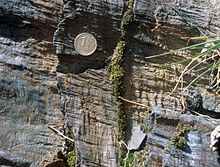Linear (geology)
In geology, the term linear refers to a linear structure on a natural rock surface that has arisen through tectonic processes . Linear occur on strata , foliation , and fault surfaces . The mostly very fine, parallel lines are divided into different types according to their origin.
Wrinkle linear

Wrinkle or krenulation lines arise from the intensive folds of very finely layered sedimentary rocks or from the folds of slate surfaces. Individual wrinkles have amplitudes from micrometers to a few millimeters.
Waste linear
Blending linear results from the blending of two differently oriented families of areas in a rock. An important linear for the analysis of the rock structure is formed by the intersection of stratification and foliation surfaces. This element, also called δ-linear in the technical literature, is oriented parallel to the fold axes and thus indirectly allows their spatial position to be determined, even if the axes are not accessible for measurements. Another frequently occurring linear is formed by the intersection of two differently oriented groups of cleavage surfaces. This element, also known as β-linear, indicates a multi-phase tectonic deformation.
Linear stretching

Linear elongation occurs in shear zones during ductile deformation in greater crustal depths . Originally isometric rock components such as pebbles, individual minerals or fossils are stretched in the direction of tectonic transport by recrystallization of the mineral substance. At the same time, fibrous minerals can recrystallize in the same direction and lead to the formation of additional lines on a rock surface.
Sliding welts
Sliding welts and armor arise on fault surfaces during tectonic movement, in a manner comparable to linear elongation. In the case of sliding welts, however, the mechanically generated deepening of grooves predominates on a surface that is polished by the sliding of stone packages against one another. Such sliding welts can also form on layer surfaces during folding. When individual layers are bent concentrically around a fold hinge, the core of a fold is more curved than layers further out. This is compensated for by the outer layers sliding towards the fold hinge. Sliding welts generally appear at a shallower depth of the crust than linear elongation.
literature
- Gerhard H. Eisbacher: Introduction to Tectonics. Pp. 122, 127-130, and 148, Enke Verlag, Stuttgart 1996. ISBN 3-432-99252-1
Web links
- Brief summary of linear structural elements, ETH Zurich (PDF; 705 kB), accessed on July 15, 2010
